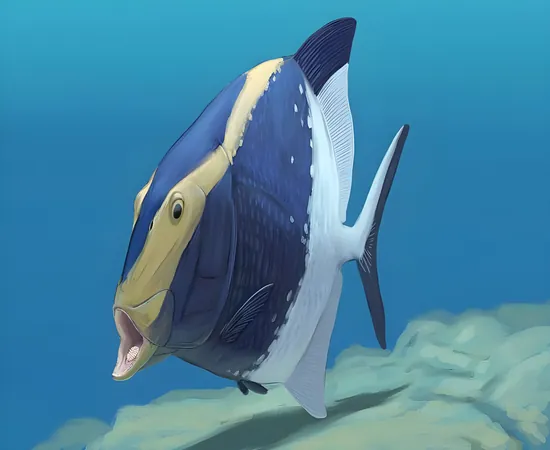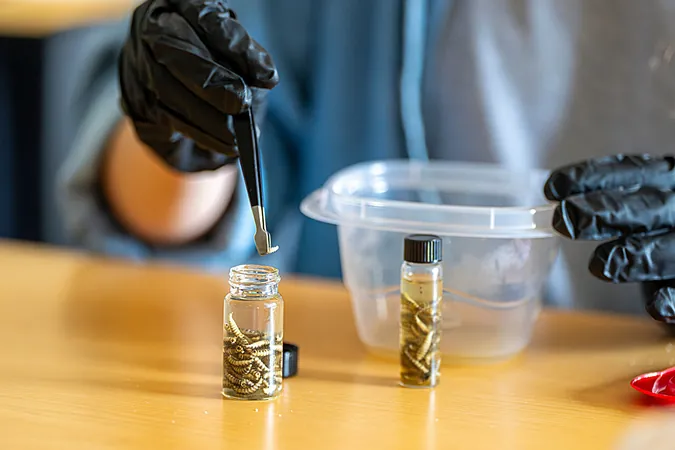
Ancient Fish Fossil Reveals Revolutionary Feeding Mechanism
2025-09-04
Author: Yu
Discovery of a Remarkable Fossil
A groundbreaking discovery in Staffordshire has unveiled a 310-million-year-old fossil of a ray-finned fish known as Platysomus parvulus, which is rewriting our understanding of prehistoric feeding strategies.
The Earliest Tongue Bite Mechanism
This ancient fish showcases one of the earliest forms of a tongue bite mechanism, a unique adaptation that enabled it to process food in innovative ways. Platysomus parvulus utilized specialized teeth situated on both the roof and floor of its mouth, allowing it to crush hard prey, such as shells and insects.
A Game-Changer in Evolutionary History
Unlike contemporary fish that depend solely on their jaws, Platysomus supplemented its bite with opposing tooth plates, creating a powerful secondary chewing surface. This discovery pulls the timeline for such adaptations back by over 150 million years, showcasing early experimentation in feeding methods that laid the groundwork for evolutionary success.
Insight into Feeding Mechanism Evolution
The fossil reveals a lower tooth plate comprised of multiple pieces, which paired with a narrow upper plate, each adorned with pointed teeth. While primitive in design compared to later versions, this arrangement illustrates the early phases of the evolution of feeding mechanisms.
The Transition to Advanced Feeding Strategies
Later fish evolved more sophisticated feeding tools with consolidated tooth plates, allowing them to grind down harder prey. This process of gradual specialization demonstrates that evolutionary advancements in jaw and gill structures did not occur simultaneously but unfolded through a series of refinements, each providing a competitive edge in ecosystems rife with challenges.
Revolutionary Insights from Paleobiology
Professor Sam Giles, lead author of the study, asserts that this discovery enhances our understanding of fish evolution post-End-Devonian Mass Extinction, which decimated numerous species. He emphasized that the evolution of tongue bites in various fish groups signifies a versatile feeding strategy vital for survival in diverse environments.
The Unique Traits of Platysomus parvulus
Unlike more advanced species that lost jaw functionality entirely, Platysomus maintained both jaws and a tongue bite, representing an evolutionary bridge between primitive jawed fish and specialists reliant on the tongue bite.
A Key to Understanding Fish Evolution
The Carboniferous period witnessed a surge in anatomical innovation among ray-finned fishes. Platysomus emerged after other lineages had adapted existing capabilities for consuming hard prey, providing significant evidence that diversification processes were gradual and complex.
Significance of the Study
This research supports the notion that fish began experimenting with different feeding strategies much earlier than previously thought, driven by ecological pressures that fostered transformative change. Platysomus parvulus encapsulates a pivotal evolutionary moment, bridging the gap between survival after mass extinction and the flourishing of intricate ecosystems.
A Step Toward Understanding Ancient Ecosystems
Research findings, published in the journal Biology Letters, position this fish as a vital piece in the puzzle of how ancient ecosystems functioned and contributed to the rich tapestry of modern fish lineages. The gradual embrace of new feeding strategies emphasizes that evolution is a stepwise journey, significantly shaping the history of life on Earth.




 Brasil (PT)
Brasil (PT)
 Canada (EN)
Canada (EN)
 Chile (ES)
Chile (ES)
 Česko (CS)
Česko (CS)
 대한민국 (KO)
대한민국 (KO)
 España (ES)
España (ES)
 France (FR)
France (FR)
 Hong Kong (EN)
Hong Kong (EN)
 Italia (IT)
Italia (IT)
 日本 (JA)
日本 (JA)
 Magyarország (HU)
Magyarország (HU)
 Norge (NO)
Norge (NO)
 Polska (PL)
Polska (PL)
 Schweiz (DE)
Schweiz (DE)
 Singapore (EN)
Singapore (EN)
 Sverige (SV)
Sverige (SV)
 Suomi (FI)
Suomi (FI)
 Türkiye (TR)
Türkiye (TR)
 الإمارات العربية المتحدة (AR)
الإمارات العربية المتحدة (AR)